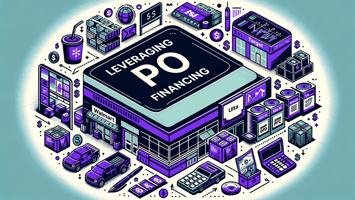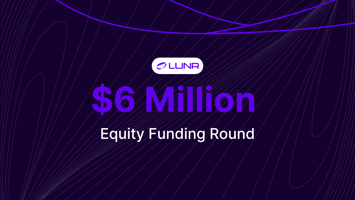Expanding into big box retail presents a major growth opportunity for consumer packaged goods (CPG)...
Financing Strategies for Retail-Ready CPG Brands

Emerging brands breaking into retail often run into the same challenge: the cash flow gap between producing inventory and getting paid by retailers. At Lunr, we help founders bridge that gap with inventory capital—funding production so brands can fulfill large orders without giving up equity or taking on traditional debt.
Lunr funds your production upfront and gets repaid when the retailer pays their invoice.
In short: when a brand has a major order from a retail partner, we fund inventory production directly by paying manufacturers. We recoup our investment when the retailer pays its invoice to the brand—which can often take 30, 60, or even 90 days after the inventory hits shelves.
Of course, inventory capital is just one tool in a broader financial toolkit. There are other forms of non-dilutive capital that support different stages of the retail cycle. Below, we’ll walk through a few of the most common options founders ask us about frequently—including purchase order (PO) financing and accounts receivable (AR) factoring—and explain how each one works.
Here’s the simplest way to think about AR Factoring and PO Financing:
PO financing → helps you produce and ship the goods.
AR factoring → helps you bridge the gap between shipment and getting paid.
Each one addresses a different point in the retail cash flow cycle. Below, we’ll break down how they work and why brands often explore them.
What is AR Factoring?
AR factoring is a financing service typically offered by third-party lenders or specialized factoring companies. It comes into play after a brand has fulfilled a wholesale order and issued an invoice–but before the retailer is required to pay.
Once the retailer receives the goods, the brand sends an invoice. At that point, the factoring partner advances most of the invoice amount–usually 80–90%–to the brand upfront. When the retailer eventually pays (often 30 to 90 days later), the factor collects the full payment and remits the remaining balance to the brand, minus a fee.
This type of financing allows brands to access cash quickly instead of waiting through long retail payment cycles.
This is especially helpful when:
- Retailers are on extended payment terms and you can't afford to wait 15–90 days for payment
- You need faster access to capital to cover payroll or inventory
- Your invoices are issued to large, creditworthy retailers–since approval is typically based on their financial strength, not yours
Factoring receivables is often the first type of financing available to early-stage brands because it doesn’t rely on the brand’s financial history. Instead, approval is typically based on the retailer’s ability to pay. That makes it accessible even for companies without a long track record or strong balance sheet.
"The real value of AR factoring is that approval is based on your customers' creditworthiness, not your own. This makes it an accessible financing option even for newer brands that haven't built up a strong balance sheet yet," explains Skylar Lane of Goodman Capital Finance.
The downside is cost. Factoring fees usually range from 1% to 5% of the invoice value, depending on the amount of time your clients take to pay the invoice. For brands with steady demand and long payment terms, it's a practical way to unlock cash and keep things moving without waiting for payment.
What is PO Financing?
PO financing steps in before production begins. When a large retailer places a confirmed order, but you don’t have the cash on hand to fulfill it, a financing partner can help by paying your supplier directly so you can start production without draining your own reserves.
It’s a forward-looking tool designed to help brands capitalize on big retail wins. Unlike AR factoring, which unlocks cash after a sale, PO financing helps you fund what you’re about to sell.
This is especially helpful when:
- You’ve secured a large retail order but don’t have the cash to fund production at scale
- Your manufacturer or co-packer requires a significant upfront deposit
- You’re working with a retailer that has strong credit—making it easier for lenders to approve financing
- You want to preserve your own working capital for marketing, hiring, or other growth priorities
For brands scaling quickly, PO financing can be the difference between turning down an opportunity and confidently saying “yes.”
Inventory financing, another way to fund growth before products hit the shelf, is a flexible funding option for brands that need to scale beyond a single purchase order. Rather than tying capital to one shipment, it allows you to borrow against your finished goods inventory, making it well-suited for seasonal production, retail launches, or multi-channel distribution. This approach gives you working capital to build inventory in advance and fulfill demand across multiple retailers or sales channels.
When Do Brands Combine AR Factoring with PO Financing?
These tools aren’t either/or. Many brands use them together to manage different points in the cash flow cycle.
A common approach is to use PO financing to fund production for a confirmed retail order, then factoring accounts receivable once the goods ship and an invoice is issued. This keeps cash moving on both ends–before and after delivery–so brands can scale without getting stuck in a liquidity crunch.
In some cases, inventory financing is layered in as well, particularly when brands are building up stock for multiple channels or seasonal demand rather than a single purchase order.
Some lenders offer all three solutions under one roof, making it easier to coordinate financing and move quickly when opportunities arise. This is especially true when they provide blended options like an AR facility or an ABL revolver, which extend working capital without adding equity dilution.
The Bottom Line
AR factoring, PO financing, and inventory financing each address different points in the retail cash flow cycle. While none are one-size-fits-all, they can be useful tools to help brands manage growth without giving up equity or delaying fulfillment.
At Lunr, we offer a full-stack approach that supports founders from the moment a retail purchase order is secured through to final payment from the retailer—backed by decades of retail experience. Our team works closely with brands to help them move fast, stay liquid, and scale with confidence.
Let’s talk if you’re preparing for your next big retail milestone:


